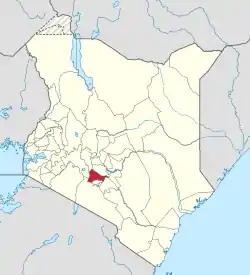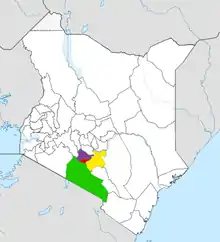Kiambu County
Kiambu County is a county in the former Central Province of Kenya. Its capital is Kiambu and its largest town is Ruiru.[3] Kiambu County is the second most populous after Nairobi County. Kiambu County borders Nairobi and Kajiado Counties to the South, Machakos to the East, Murang'a to the North and North East, Nyandarua to the North West, and Nakuru to the West and has a population of 2,417,735.[4][5]
Kiambu County | |
|---|---|
 The fourteen Falls | |
 Flag | |
 Location in Kenya | |
| Coordinates: 1°10′S 36°50′E | |
| Sovereign state | |
| Region | Central Province |
| Established | 4 March 2013 (by 2010 Constitution of Kenya) |
| Preceded by | Central Province |
| Capital | Kiambu |
| Seat of Government | Thika Town |
| Wards | 60[1] |
| Government | |
| • Governor | Kimani Wamatangi |
| • Judiciary | 12 |
| Area | |
| • Total | 2,449.2 km2 (945.6 sq mi) |
| Population (2019 census) | |
| • Total | 2,417,735 |
| • Density | 990/km2 (2,600/sq mi) |
| Time zone | UTC+3 (East Africa Time) |
| Senator | Karungo Wathang'wa |
| Woman Member of National Assembly | Ann wa muratha |
| County Assembly | County Assembly of Kiambu |
| Speaker | Stephen Ndichu[2] |
| Website | www |
The county is 40% rural and 60% urban owing to Nairobi's consistent growth Northwards. The Kikuyu are the dominant tribe in the county. Kiambu is also an economic and political powerhouse in Kenya due to its sprawling population and relatively urban and educated populace. The county features the second most universities only behind Nairobi.
In 2007, Kiambu District was subdivided in two: Kiambu East and Kiambu West. Kiambu West district took Limuru, Lari and Kikuyu divisions,[6] with Limuru as its district capital.
Climate
The county has an average annual rainfall of 1,200 millimetres (47 in) and mean temperature of 26 °C (79 °F) with temperatures as low as 7 °C (45 °F) in the upper highlands areas of Limuru. The long rains start in mid-March and run to May, and cold runs between July and August.[7]
Demographics
According to the 2019 census, there is a total population of 2,417,735 in the county: 1,187,146 males, 1,230,454 females, and 135 intersex persons. There are 796,241 households with an average household size of 3.0 persons per household and a population density of 952 people/km2.[8]
| Sub-County | Male | Female | Intersex | Total |
|---|---|---|---|---|
| Gatundu North | 54,189 | 55,678 | 3 | 109,870 |
| Gatundu South | 60,384 | 61,714 | 5 | 122,103 |
| Githunguri | 82,037 | 83,187 | 8 | 165,232 |
| Juja | 148,446 | 152,480 | 22 | 300,948 |
| Kabete | 97,794 | 101,845 | 14 | 199,653 |
| Kiambaa | 115,690 | 120,695 | 15 | 236,400 |
| Kiambu | 69,661 | 76,225 | 17 | 145,903 |
| Kikuyu | 90,919 | 96,198 | 5 | 187,122 |
| Lari | 67,061 | 68,238 | 4 | 135,303 |
| Limuru | 79,632 | 79,682 | 159,314 | |
| Ruiru | 180,947 | 190,144 | 20 | 371,111 |
| Thika East | 19,688 | 19,264 | 4 | 38,956 |
| Thika West | 120,698 | 125,104 | 18 | 245,820 |
| Total | 1,187,146 | 1,230,454 | 135 | 2,417,735 |
Religion
Religion in Kiambu County [10]
| Religion (2019 Census) | Number |
|---|---|
| Catholicism | 588,975 |
| Protestant | 882,779 |
| Evangelical Churches | 525,366 |
| African instituted Churches | 187,238 |
| Orthodox | 17,670 |
| Other Cristian | 120,492 |
| Islam | 21,311 |
| Hindu | 1,311 |
| Traditionists | 3,117 |
| Other | q19,515 |
| No ReligionAtheists | 30,770 |
| Don't Know | 3,854 |
| Not Stated | 436 |
Administrative and political units
Administrative units
Administratively, the county is divided into 12 constituencies, 60 county assembly wards, 97 locations and 257 sub-locations.
Electoral constituencies
Political leadership
Kimani Wa Matangi is the governor of Kiambu county following his election win on a UDA Ticket and successful swearing-in after the 2022 General election. He is deputised by H.E. Rosemary Kirika who hails from Gatundu-North subcounty.
Although the capital is Kiambu town, the Executive conducts business from Thika town. Due to its large Agikuyu dominated populace, Kiambu tends to deliver large votes during presidential elections. In the 2017 presidential election Uhuru Kenyatta, the Jubilee party frontrunner received 912,607 votes in the county, which is the most votes ever received from a single county in Kenya's election history, actually this accounted for nearly sixty percent of Kenyatta's margin of victory in the election. The current Kenya Kwanza government has its most members of Parliament from the county.
| Number | |
|---|---|
| Governor | 1 |
| Deputy Governor | 1 |
| County Secretary | 1 |
| CEC Members | 10 |
| Total | 13 |
Legislature
The legislature of Kiambu County is a unicameral County Assembly. It comprises 60 elected Members of County Assembly (MCA) from the 60 wards of the county and 27 nominated members.[1] The members hold office for a five-year term each, renewable during the general election. The speaker and deputy speaker of the assembly are elected by the MCAs. The County Assembly is located at Kiambu town.
Judiciary
The Kiambu High Court was established on 20 June 2016.[12] As of 2017, it consists of a one-judge bench. It is temporarily located at Thika waiting for a permanent building to be constructed at Kiambu, the capital.
County administration
The county has a county administrator who is appointed by the President of Kenya. He is not part of the county government but is a representative of the President to assist with matters of administration in the county with regards to the national government.[13]
Education
In Kiambu County, there are 1,515 ECD centers, 948 primary schools, 365 secondary schools, 33 youth polytechnics, 165 adult education centers, one technical training institution, one technical institute of technology. There are four universities:[14] one public, Jomo Kenyatta University of Agriculture & Technology[15] and four private universities, Gretsa University,[16] UMMA University,[17] Mount Kenya University[18] and Zetech University.
| Category | Public | Private | Total | Enrolment |
|---|---|---|---|---|
| ECD Centres | 552 | 963 | 1515 | 99,061 |
| Primary Schools | 476 | 472 | 948 | 326,770 |
| Secondary Schools | 271 | 94 | 365 | 116,366 |
| Youth Polytechnics | 33 | 0 | 33 | |
| Technical Training Institutes | 1 | 0 | 1 | |
| Adult Education Centres | 165 | 0 | 165 | 6,128 |
| Institutes of Technology | 1 | 0 | 1 | |
| Universities | 1 | 4 | 5 |
Health
Kiambu County has a total of 505 health facilities: 108 are public, 64 faith-based, and 333 private. Kiambu County has 2,652 health personnel of different cadre with a doctor/population ratio of 1:6,667, while the nurse population ratio is at 1:1,110. The immunization coverage is at 89%, close to the national target of 90%.[20]
According to 2016 estimates, HIV prevalence is at 5.6% (below the national 5.9%) and the county is ranked 6th in terms of HIV burden.[21]
| Government | FBO | Private | TOTAL | |
|---|---|---|---|---|
| Hospitals | 14 | 11 | 26 | 51 |
| Health centres | 33 | 8 | 0 | 41 |
| Dispensaries | 72 | 21 | 0 | 93 |
| Clinics | 0 | 0 | 147 | 147 |
| Total | 119 | 40 | 173 | 332 |
Transport and communication
The county is covered by 2,049 kilometres (1,273 mi) of road networks. Of this, 459 kilometres (285 mi) is covered by earth surface, 1,075.8 kilometres (668.5 mi) is murram surface, and 515 kilometres (320 mi) is covered by bitumen.[24]
There are 19 Post Offices.[23]
Trade and commerce
There are 302 trading centers, 118 markets, 364 retail supermarkets, 5,813 registered businesses, 5,807 licensed retail traders and 5,740 licensed wholesale traders.[23][25]
Tatu City is a special economic zone and an industrial park located in Ruiru sub-county. Apart from real estate, individuals and organizations have also invested in processing. Companies operating in Kiambu include: Farmers Choice Ltd, 25 Kenchic Co. Ltd, Brookside Dairies, Githunguri Dairies, Ndumberi Dairies, Limuru Milk and Palmside Dairies. Kiambu has the second largest economy in Kenya, largely due to its sprawling population and close proximity to the capital city. Kiambu also has the second most educated populace of any county in Kenya.
Thika sub-county has 58 industries, including Bidco Oil Industries, Devki Steel Mills, Broadway Bakeries and Kenblest, among others.[26]
Constituencies and sub-counties
The county has twelve constituencies and fourteen sub-counties.[27][28] Of the twelve constituencies, Lari occupies the largest land mass at 439.2 km2 (169.6 sq mi), while Kabete is the smallest by landmass as it occupies 60.3 km2 (23.3 sq mi).
| Constituency | Area (km2) | No. of Wards | Electoral Wards |
|---|---|---|---|
| Lari | 439.2 | 5 | Kinale Ward, Kijabe Ward, Nyanduma Ward, Kamburu Ward, Lari/Kirenga Ward |
| Juja | 326.6 | 5 | Murera Ward, Theta Ward, Juja Ward, Witeithie Ward, Kalimoni Ward |
| Ruiru | 291.9 | 8 | Gitothua Ward, Biashara Ward, Gatongora Ward, Kahawa/Sukari Ward, Kahawa Wendani Ward, Kiuu Ward, Mwiki Ward, Mwihoko Ward |
| Gatundu North | 286.0 | 4 | Gituamba Ward, Githobokoni Ward, Chania Ward, Mang'u Ward |
| Limuru | 281.7 | 5 | Bibirioni Ward, Limuru Central Ward, Ndeiya Ward, Limuru East Ward, Ngecha Tigoni Ward |
| Kikuyu | 236.1 | 5 | Karai Ward, Nachu Ward, Sigona Ward, Kikuyu Ward, Kinoo Ward |
| Thika Town | 217.5 | 5 | Township Ward, Kamenu Ward, Hospital Ward, Gatuanyaga Ward |
| Gatundu South | 192.4 | 4 | Kiamwangi Ward, Kiganjo Ward, Ndarugo Ward, Ngenda Ward |
| Kiambu | 189.1 | 4 | Ting'ang'a Ward, Ndumberi Ward, Riabai Ward, Township Ward |
| Githunguri | 173.5 | 5 | Githunguri Ward, Githiga Ward, Ikinu Ward, Ngewa Ward, Komothai 3 Ward |
| Kiambaa | 83.2 | 5 | Cianda Ward, Karuri Ward, Ndenderu Ward, Muchatha Ward, Kihara Ward |
| Kabete | 60.3 | 5 | Gitaru Ward, Muguga Ward, Nyathuna Ward, Kabete Ward, Uthiru Ward |
| Total | 2,543.5 | 233 | 233 |
Sub-counties
Sub-counties are mostly derived from constituency boundaries but two constituencies, Ruiru and Thika, have two sub-counties each.[31]
- Gatundu North Sub-county
- Gatundu South Sub-county
- Githunguri Sub-county
- Githurai Sub-county[32]
- Kabete Sub-county
- Kiambaa Sub-county
- Kiambu Sub-county
- Kikuyu Sub-county
- Juja Sub-county
- Lari Sub-county
- Limuru Sub-county
- Ruiru Sub-county
- Thika East Sub-county
- Thika West Sub-county
Population
| Year | Population | Variation |
|---|---|---|
| 1979 | 686,290 | – |
| 1989 | 914,412 | |
| 1999 | 1,389,723 | |
| 2009 | 1,623,282 | |
| 2019 | 2,417,735 | |
Nairobi Metro
Part of southern areas of Kiambu County are within Greater Nairobi, which consists of four out of 47 counties in Kenya.[34][35]
Stats
Urbanisation
| County | Urbanisation in Nairobi Metro (Per cent) | ||||||||
|---|---|---|---|---|---|---|---|---|---|
| Nairobi County | 100 | ||||||||
| Kiambu County | 60.8 | ||||||||
| Machakos County | 52 | ||||||||
| Kajiado County | 41.4 | ||||||||
32.3 | |||||||||
|
Urbanisation by County within Nairobi Metro | |||||||||
Source: OpenDataKenya
Wealth/Poverty Level
| County | Poverty Level in Nairobi Metro (Per cent) | ||||||||
|---|---|---|---|---|---|---|---|---|---|
| Kajiado County | 11.6 | ||||||||
| Kiambu County | 21.8 | ||||||||
| Nairobi County | 22 | ||||||||
| Machakos County | 59.6 | ||||||||
45.9 | |||||||||
|
Poverty level by County | |||||||||
Source: OpenDataKenya Worldbank
Urbanisation
| County | Urbanisation in Central Kenya (Per cent) | ||||||||
|---|---|---|---|---|---|---|---|---|---|
| Kiambu County | 60.8 | ||||||||
| Nyeri County | 24.5 | ||||||||
| Nyandarua County | 18.5 | ||||||||
| Muranga County | 16.3 | ||||||||
| Kirinyaga County | 15.8 | ||||||||
32.3 | |||||||||
|
Urbanisation by County in Central Kenya | |||||||||
Source: OpenDataKenya
Wealth/poverty level
| County | Poverty Level in Central Kenya (Per cent) | ||||||||
|---|---|---|---|---|---|---|---|---|---|
| Kirinyaga County | 25.2 | ||||||||
| Muranga County | 28.5 | ||||||||
| Kiambu County | 28.9 | ||||||||
| Nyeri County | 32.7 | ||||||||
| Nyandarua County | 46.6 | ||||||||
45.9 | |||||||||
|
Poverty level by County | |||||||||
Source: OpenDataKenya Worldbank
External links
See also
References
- "Political Units". County Government of Kiambu. Retrieved 31 August 2021.
- "Ex-Juja MP Ndichu is Kiambu Speaker". Daily Nation. 8 September 2017. Retrieved 14 April 2018.
- "Background of Kiambu County". County Assembly of Kiambu. Retrieved 25 May 2020.
- "Kiambu County (Kenya)". crwflags.com. Retrieved 26 May 2020.
- "Kiambu Position and Size". Kiambu County Government. Retrieved 28 May 2020.
- "Kiambu District now split into two". Kenya Broadcasting Corporation. 19 February 2007. Archived from the original on 27 September 2007.
- Kiambu County Integrated Development Plan CIDP 2018-2022 (PDF). County Government of Kiambu. 2018. p. 3.
- Munene, Evans (4 November 2019). "2019 Kenya Population and Housing Census Results". Kenya National Bureau of Statistics. Retrieved 28 May 2020.
- 2019 Kenya Population and House Census: Population by County and Sub-county, Volume 1. Kenya National Bureau of Statistics. 2019. pp. 26, 35, 44. ISBN 9789966102096.
- "2019 Kenya Population and Housing Census Volume IV: Distribution of Population by Socio-Economic Characteristics" (PDF). Kenya National Bureau of Statistics. Retrieved 2 May 2021.
- "179. County executive committees". Kenya Law Reform Commission. Retrieved 28 May 2020.
- "Kiambu gets High Court · Welcome :: Republic of Kenya - the Judiciary". Archived from the original on 11 October 2017. Retrieved 10 October 2017.
- "The County Government Act 2012". Constitution and Reform Education Consortium. Archived from the original on 3 June 2020. Retrieved 28 May 2020.
- "Education, Gender, Culture & Social Services". Kiambu County Government. Retrieved 28 May 2020.
- "History". jkuat.ac.ke. Retrieved 26 January 2021.
- "Gretsa University – Quality Education For the Real World". Retrieved 26 January 2021.
- "Umma Profile". Umma University. Archived from the original on 1 February 2021. Retrieved 26 January 2021.
- "Main Campus,Thika". mku.ac.ke. Archived from the original on 26 January 2021. Retrieved 26 January 2021.
- "Publications". Kenya National Bureau of Statistics. Retrieved 28 May 2020.
- "CoG Reports - Kiambu County Integrated Development Plan CIDP 2018-2022". The Council of Governors. Retrieved 28 May 2020.
- "Kenya HIV County Profiles 2016" (PDF). National AIDS Control Council. 2016. Retrieved 28 May 2020.
- "Health Services". Kiambu County Government. Retrieved 28 May 2020.
- "County Statistical Abstract Kiambu County 2015". Kenya National Bureau of Statistics. 2015. Retrieved 28 May 2020.
- "Kenya Rural Roads Authority". Kenya Rural Roads Authority. Retrieved 28 May 2020.
- "Trade, Tourism, Industries & Enterprise Development". Kiambu County Government. Retrieved 28 May 2020.
- "Kiambu County Integrated Development Plan CIDP 2018-2022". County Government of Kiambu. 2018. Retrieved 28 May 2020.
- "County Government of Kiambu – Home". Archived from the original on 8 August 2013. Retrieved 20 June 2016.
- "County Wards". Archived from the original on 11 October 2017. Retrieved 10 October 2017.
- "Political Units".
- https://www.nema.go.ke/images/Docs/EIA_1860-1869/ESIA-%20Muthaiga-Kiambu-Ndumberi%20ESIA%20Final%20Report%20-%20April%202020-min.pdf
- "The Kenya Gazette: Vol. CXXII —No. 9" (PDF). The Kenya Gazette. 17 January 2020. Retrieved 30 October 2022.
- "The Kenya Gazette: Vol. CXXIV—No. 21" (PDF). The Kenya Gazette. 31 January 2022. Retrieved 30 October 2022.
- "KENYA: Administrative Division population statistics". CityPopulation.de. Retrieved 31 August 2021.
- .
